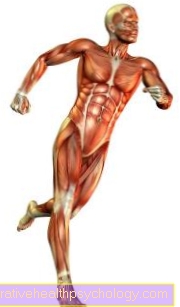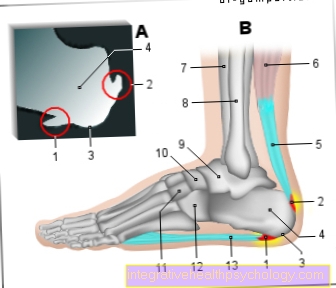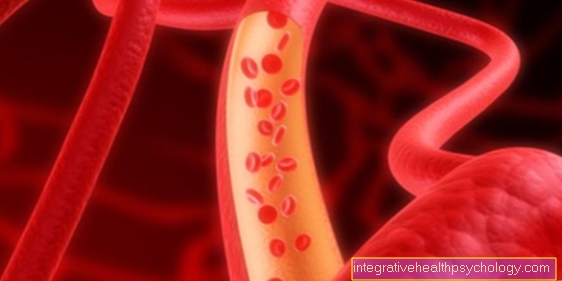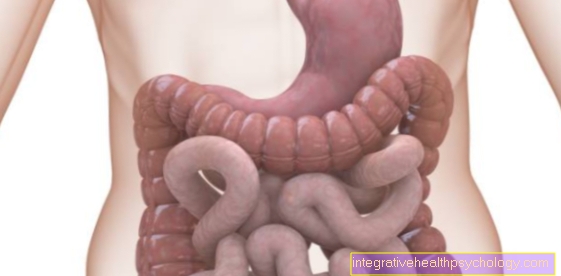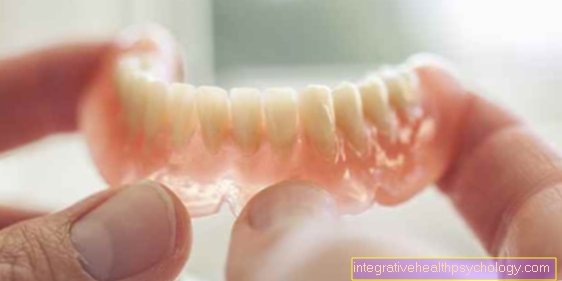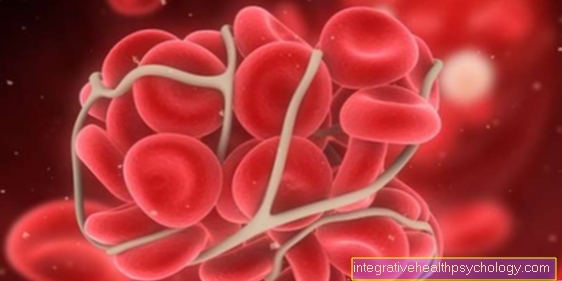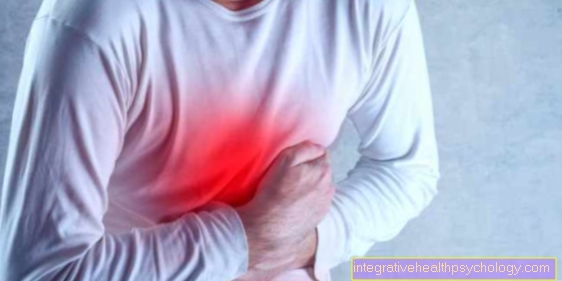Digestive tract
synonym
Gastrointestinal tract
definition
The term digestive tract is an organ system of the human body that is responsible for the intake, digestion and utilization of food and fluids and is essential for a problem-free life.

Classification of the gastrointestinal tract
The digestive tract of the human body is divided into an upper and a lower digestive tract.
Upper digestive tract: the upper digestive tract includes the mouth and throat area, through which food and fluids are absorbed. The primary processing of the food is carried out here. The food is mechanically chopped up in the mouth by the teeth and moistened by the salivary glands of the oral cavity. These two mechanisms are used in preparation for the swallowing process. It is important that the food is chopped up into small bites when doing this. Only in this way can it pass through the adjoining digestive tract in size. The purpose of salivating is to make the bites slip better.
After the oropharynx, the food passes through the esophagus. The epiglottis, which closes the windpipe when swallowing, pushes the food in the right direction into the esophagus. Rhythmic contraction of the muscles of the esophagus ensures that the food is pushed downwards. After a length of approx. 50-60 cm, the food reaches the stomach. This is where the mechanical processing of the food ends. From here on there are increasing chemical and enzymatic cleavage processes. There is a very acidic environment in the stomach. This ensures that bacteria that are present in every food are killed. Muscular kneading movements continue to reduce the size of the bites. The bite of food that was once consumed has turned into a chyme in the stomach, which is then passed on to the duodenum. This is where the so-called lower gastrointestinal tract begins.
Further information on the anatomy of the abdominal cavity can be found here: Abdominal cavity
Illustration of the digestive tract

Digestive tract
A. - Food route
a - digestive organs
in the head and neck
(upper part of the digestive tract)
b - digestive organs
in the body cavity
(lower part of the digestive tract)
- Oral cavity - Cavitas oris
- Tongue - Lingua
- Sublingual salivary gland -
Sublingual gland - Trachea - Trachea
- Parotid gland -
Parotid gland - Throat - Pharynx
- Mandibular salivary gland -
Submandibular gland - Esophagus - Esophagus
- Liver - Hepar
- Gallbladder - Vesica biliaris
- Pancreas - Pancreas
- Colon, ascending part -
Ascending colon - Appendix - Caecum
- Appendix -
Appendix vermiformis - Stomach - Guest
- Large intestine, transverse part -
Transverse colon - Small intestine - Intestine tenue
- Colon, descending part -
Descending colon - Rectum - Rectum
- Nach - anus
You can find an overview of all Dr-Gumpert images at: medical illustrations
Lower gastrointestinal tract: The Duodenum (Duodenum) absorbs the chyme coming from the stomach. Here he is with the Bile acidsthat are in the liver formed and in the Gallbladder are stored. This leads to a further breakdown of the food. About the pancreas enzymes for fat splitting now also arrive (Lipase) into the digestive tract and are mixed with food.
The is attached to the duodenum Small intestine , which in turn is divided into further sections, but which flow smoothly into one another. One still differentiates that Jejenum and the Ileum. These sections are traversed by the now almost liquid chyme, some nutrients are withdrawn from the food and made available to the body cells via the blood. The is attached to the small intestine system Colon (Colon) at. One of its main tasks is that detoxification and the Thickening of the porridge. The withdrawal of water is particularly important, as the liquid in the food can be returned to the body in a kind of recycling process in addition to the amount of drink supplied. As long as the food is in the large intestine, it becomes thicker and thicker with increasing dehydration. Now there are only unusable food components and toxins that are left in the intestine. All the necessary nutritional components have so far been withdrawn from the chyme and fed back into the body.
Part of the colon is called the rectum designated. That also as rectum The designated end of the intestinal system serves as a storage section that is used to hold back the stool that has been prepared for excretion until the amount and consistency is sufficient to start defecation. As the amount of stool increases, so does the pressure inside the rectum. The urge to defecate is now triggered in humans via certain nerve tracts. With the elimination of the stool, the digestive passage from food intake to elimination ends. From start to finish, the food has a duration of 60 to 120 hours covered.
The digestive mechanisms are basically the same for every person, but differ a little individually in terms of stool frequency. On average, the bowel movement will daily or every two days eliminated. But it can also happen that defecation occurs every three days. An increased stool frequency up to a maximum of 3 stools a day is still considered physiological. Frequent bowel movements should be clarified medically, as a metabolic or digestive disorder can always be the background for this. If there has been no bowel movement after about a week, laxative measures should be initiated. Also a possible one Intestinal obstruction (Ileus) should be excluded in this case.
Intestines
Life is not possible without the gut. The vital digestion is controlled and guaranteed through it. The food and the fluids enter the human body via the intestines, and this is where the breakdown into usable and non-usable constituents of the food takes place. The human intestine is divided into numerous sections, each of which has different tasks and parts in the digestive process.
The main division is the distinction between the small intestine and the large intestine. The small intestine and all its sections are attached to the stomach. A distinction is made between the duodenum (Duodenum), which connects directly to the gastric outlet. In it, the bile acids get from the gallbladder, where they are stored, to the food that is already sufficiently reduced in size and mixed with fluid in the duodenum. Rather, it is now a chyme that pushes its way through the tight intestinal plexus through rhythmic muscle movements. The chemical digestion of the chyme begins with the mixing of bile acids. Produced by the pancreas, enzymes reach the small intestine, which break down the various fats. The most important enzymes are lipase and amylase. The jejenum is attached to the duodenum. It makes up about 40% of the small intestine.
The remaining 60% are made up of the so-called ileum. The main task of these sections of the small intestine is to knead the chyme and to absorb nutrients. In addition to the required nutrients, folic acid, vitamin C and calcium in the small intestine are also removed from the chyme. Since food is contaminated with bacteria to a not inconsiderable extent, a large part of the human immune and defense system is located in the intestine in order to quickly eliminate the corresponding pathogens and intruders. The defense system is created in the form of lymphatic structures. The optimal absorption of the nutrients is achieved by a mucous membrane that spreads in waves and slides the entire inner wall of the small intestine. The villi protrude into the intestinal lumen and thus come into contact with the chyme that is pushed through the intestine. Shortly after the duodenum, the villi are largest; the further the intestine descends, the flatter they become. They are almost no longer recognizable up to the colon. The small intestine takes up a large area, which is also enlarged by the ingenious folds. It also offers a large target area for diseases. Common bowel diseases can be autoimmune and are known as ulcerative colitis or Crohn's disease. Symptoms are severe diarrhea, sometimes accompanied by blood and cramps.
You might also be interested in: Task of enzymes in the human body

To the Small intestine closes the Colon which is also called colon referred to as. Here there is no longer the anatomical folds of the mucous membrane that protrude into the chyme. The walls are flatter and smoother, and a large part of the nutrient utilization has already been completed in this section of the digestive tract. The large intestine begins at an anatomical structure that strictly separates the small intestine from the large intestine. This structure is also called the Bauhinsche flap designated. It follows the appendix (appendix), which is found in the lower right part of the abdomen in most people. If it was previously believed that this section of the intestine had no essential tasks, today it is known that a large part of the immune response occurs in the appendix. Most of them are familiar with this section of the intestine, possibly from their own experience, because the Spinous process of the appendix can become inflamed and must then be surgically removed in most cases.
By definition, the actual large intestine begins (colon) just behind the appendix. With the colon one differentiates one ascending part (Pars ascendens), one transverse part (Pars transversum) and one descending part (Pars descendens). Viewed from the front, the large intestine forms a kind of frame, in the middle of which the small intestine is embedded. Viewed from the outside, the large intestine is characterized by constrictions, also known as House doors are designated. Its main task is the absorption of minerals and the removal of water from the chyme. In total, the large intestine can process 300 ml of chyme into 150 g of stool. In addition to the absorption of important minerals, substances are also released into the intestine and thus made to be excreted. Above all, that should be mentioned here potassium and the Bicarbonate, which has important buffering functions and is excreted via the intestines in the event of increasing alkalinization of the body. Numerous toxins are also ultimately excreted via the large intestine and thus leave the body unnoticed. The intestine is never sterile and is flooded with numerous bacteria that are part of the intestinal flora. The task of the numerous bacteria are defense against pathogens through a natural barrier function, support of the metabolism in the colon mucosa and acceleration of exchange processes (exchange of nutrients etc. on the intestinal wall). They also stimulate bowel activity and the mechanical movement of the bowel. In addition, the stimulation of the immune system is counted among the tasks of the bacteria. Through the Intestinal flora an optimal environment is maintained in the intestine, which maintains the exchange processes of nutrients and pollutants. A disproportion of the intestinal flora leads to the overturning of the balance and ultimately to Diarrhea. Often this is after a long period of time Taking antibiotics to observe.
rectum
The Colon makes an S-shaped bend. This section is called Sigmoidum designated. It is the last link between the large intestine and the final rectum. The rectum is also called rectum designated. Above all, it is a reservoir and stores prepared stool that is intended to be eliminated. The rectum begins at about the level of the Sacrum. The rectum has a length of approx. 15-20 cm. It ends in anus, which in addition to the perineal muscles also from Sphincters are formed. These sphincters hold back the bowel movement and thus ensure sufficient continence. The inside of the rectum is covered with a Venous plexus streaked. If there is a bulging of this vascular system, the known ones occur hemorrhoids. Such haemorrhoids can develop, especially with solid stool or with increased pressures during defecation. There are several stages of hemorrhoids. Bulging vessels always present the risk of injury. If it comes to that, one speaks of one Hemorrhoidal bleedingthat can not be negligible. Venous plexus sacs can be treated with a variety of ointments, or surgery can be performed. In diseases of the intestine that require surgical removal of sections of the intestine, it is important that a large part of the rectum is preserved. Otherwise there is a great risk of one Incontinence. Does it come to blood deposits in the stool or so-called in patients Tarry stool, should definitely pass the bowel through a reflection (Colonoscopy) to be examined. A so-called digital rectal examination should be done in any case if blood is detected in the stool. Here the rectal wall can be felt, constrictions can be found and it can also be checked whether the ampoule of the rectum is filled with stool and whether this is blood-free or if there is blood. If the infestation is pronounced, the digital rectal examination can already suspect a Rectal cancer which can be noticeable in a pronounced constriction. In addition to the digital rectal examination, one should definitely have one if there is any suspicion Rectoscopy carry out. This is a colonoscopy in which only the rectum is seen. To carry out this procedure, much less effort and preparation is required than with a "large" colonoscopy. Most of the time, shortly before the procedure, the patient only gets a purgative suppository to empty the rectum and thus allow a corresponding insight. A rigid instrument is then inserted into the anus and the rectum is inspected while advancing.






.jpg)

